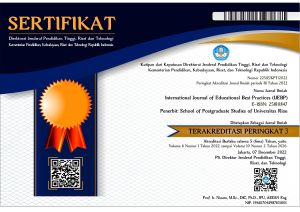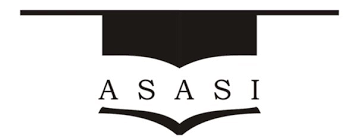TEACHERS’ PROFILES AFTER THE IMPLEMENTATION OF TEACHER CERTIFICATION PROGRAM: AN EVALUATION
DOI:
https://doi.org/10.31258/ijebp.4.1.64-76Keywords:
teachers profile, professional teachers, evaluationAbstract
This research aimed at evaluating the profile of teachers after the implementation of the certification program within the periods of 2006– 2015. The sample of this research was 367 teachers in Riau Province-Indonesia. Since this research evaluated input, process, and inhibiting factors in conducting pedagogy, professional, and the combination of pedagogy & professional competencies; the Context, Input, Process, and Product (CIPP) evaluation model was used. The research findings revealed that in the input factor, the aspects of knowledge on technology, information & communication (2.8856) and materials, structure, concept, & professional mindset (2.9319) were at a moderate level. Meanwhile, in the process factor, the aspects of reflective action for the improvement of learning quality (2.7036); and use of technology, information, communication dealing with self improvement (2.8283) were also in moderate level; but in low level for the aspect of creativity in material development In case of inhibiting factors, teachers have problems with copying facilities of learning materials, test, & quiz (65.7%); compulsory teaching load per week (73.0%); activities of classroom and subject teachers working group (67.6%); the utilization of school operation fund (76.3%); the process of promotion (65.4%); appointed to have additional jobs (95.6%); certification fund (50.1%); school library (22.9%); workshop, training, upgrading for teachers (43.6%); and reduction of certification fund (31.6%). However, there was no significant difference in the factors of input and process viewed from the aspects of types of teachers, academic qualification, teaching experience, and gender.
References
_________. Definisi Kompetensi Guru. www.jejakpendidikan.com (retrieved from https://www.google.com, 23 April 2020).
_________. Definisi Kompetensi Guru. id.wikipedia.org. (Retrieved from https://www.google.com, 23 April 2020).
_________. Definisi Kompetensi Guru. rasto.staf.upi.edu (retrieved from https://www.google.com, 23 April 2020).
_________.Definition of profile. (retrieved on 21 September 2019 from https://www.thefreedictionary.com/profile)
_________. Definition of profile. (Retrieved on 21 September 2019 from https://dictionary.cambridge.org/dictionary/english/profile).
_________. A Letter of Decree of Minister of Education & Culture Republic of Indonesia Number 37 the Year 2017 on certification for teachers (Retrieved on 21 September 2019 from https://www.infoukg.com/2017/12/peraturan-ppg-2018-permendikbud-no-37.html
_________. A Letter of Decree of Minister of National Education Republic of Indonesia Number 87 the Year 2013 on PPG Program (Retrieved on 21 September 2019 from https://bumipendidik.blogspot.com/2014/07/permendiknas-no-87-tahun-2013-tentang.html.
_________. 10 Criteria to be professional Teachers. (Retrieved on 21 September 2019 from https://blog.ruangguru.com/inilah-10-kriteria-untuk-jadi-guru-profesional).
_________. The Law of the Republic of Indonesia Number 14 the Year 2005 about Teachers and Lecturers. In PGRI (2006).
_________. Australian Institute for Teaching and School Leadership Limited. (2015). Australian Standards for teachers (Retrieved on 22 September 2019 from www.aitsl).
________. Mc.Leod (in Usman, 2004:14). (Retrieved on 22 September 2019 from https://schoolash.blogspot.com/2012/02/definition-of-teacher-competence.html).
________.Professional teachers. (Retrieved on 9 December 2018) from www.wikihow.com/Be-a-Professional-Teacher#Image
Ahmad, K. (2009). Penelitian Tindakan Kelas (Classroom Action Research). Langkahlangkah pelaksanaannya (Steps of implementation). Jurnal Pendidikan Penabur. No. 12, Tahun ke-8, Juni 2009.
Arikunto, S. (2010). Prosedur Penelitian (Educational Procedure). Suatu Pendekatan Praktik (A Practical Approach). Jakarta. PT Aneka Cipta.
Brown, D.H. (2004). Language Assessment. Principles and classroom practices. New York: Pearson Education, Inc.
Clarke, D. & Hollingsworth, H. (2002). Elaborating a model of teacher professional growth. Teaching and teacher education 18 (20020 947967.www.elsevier.com/locate/tate.
Collins Cobuild Essential English Dictionary. (1989). London. Collins ELT.
Creswell, W.J. (2005). Educational Research. Second Edition. New Jersey. Pearson Merrill Prentice Hall.
Erman, S. & Yaya, S. (1990). Kriteria Penentuan Hasil Belajar (Determining Learning Achievement Criteria). Bandung. Wijaya Kusuma.
Gredler, E.M. (1996). Program Evaluation. New Jersey. Merrill Englewood cliff.
Guskey, R.T. (2002). Professional development and teacher change. Teachers and teaching: theory and practice. Vol. 8, No. ¾, 2002. Carfax Publishing.
Jackson, L.S. (2003). Research Methods and statistics. Australia. Wadsworth.
Johnson, B. & Christensen, L. (2000). Educational Research. Quantitative and qualitative approaches.
Kemendikbud. (2012). Kebijakan Pengembangan Profesi (Policy of Developing Profession). Materi Pendidikan dan Latihan Profesi Guru (Materials for Education & Traning of Teacher Profession). Jakarta: Badan Pengembangan SDM dan Penjaminan Mutu Pendidikan.
Kemendikbud. (2013). Material for training. The Implementation of Curriculum 2013. Junior high schools. Jakarta: Kemendikbud.
Kemendikbud. (2012). Permendikbud Nomor 57 Tahun 2012 tentang Uji Kompetensi Guru (A Letter of Decree of Minister of Education and Culture Republic of Indonesia Number 57 Year 2012 on Teacher Competency Test). Dalam ditjen Guru dan Tenaga Kependidikan kemendikbud. Jakarta. Panduan Kegiatan Workshop Studi Analisis Hasil UKG Tahun 2015.
Krueger, R.A. (1994). Focus Group. A Practical guide for applied approach. Newbury Park, CA: Sage Publication.
Kwang, N.A. (2001). Why Asians less creative than westerners. University of Queensland. (Retrieved from www.idearesort.com/trainers/To1.p on 1 October 2019).
Nadhirin. (2013). Guru Profesional (Professional Teachers). (Retrieved on 21 September 2019 from https://nadhirin.blogspot.com/2013/05/guru-profesional_7.html).
Nessipbayeva, O. The competencies of Modern teacher. Part 2: Pre-service and Inservice Teacher Training. Suleyman Demirel University. Almaty, Kazakhstan. [email protected] (Retrieved on https://archive.org/details/ERIC_ED567059) 9 October 2019
Nurhayati, B. (2006). Faktor-faktor yang mempengaruhi profesionalisme dan kinerja guru Biologi di SMAN Kota Makassar Sulawesi Selatan (Factors influencing professionalisms and performance of Biology Teachers of SMAN Kota Makassar South Sulawesi). Jurnal Mimbar Pendidikan. No. 4/XXV/2006.
Ono, Y. & Ferreira, J. (2010). A case study of continuing teacher professional development through lesson study in South Africa. South African Journal of Education EASA. Vol. 30:59-74. (Retrieved on 14 October 2018).
Phyall , Erika. (2013). How to Become a Teacher in Georgia. (Retrieved on 21 September 2019 from https://rossieronline.usc.edu/how-to-become-a-teacher-in-georgia).
Riau Pos. (2014). Kurikulum dari masa ke masa (Curriculum from era-to-era). Pekanbaru. Riau Pos, 20 October 2014. P.8).
Rossi, H.P. & Freeman, E.H. (1988). Evaluation: A systematic approach. Third Edition. London. Sage Publications.
Saityasa, W.I. (2008). Dimensi-dimensi teoritis peningkatan profesionalisme guru (Dimension theory of teacher professionalism development). Jurnal pendidikan dan pengajaran UNDHIKSHA. Edisi khusus. Th XXXXI Mei 2008. ISSN 02158250 (pp. 473-494).
Sanaky, H. (2005). Sertifikasi dan profesionalisme guru di era reformasi pendidikan (Certification and teacher professionalism in educational reformation era). Jurnal Pendidikan Islam, Jurusan tarbiyah (Retrieved on 10 October 2019).
Stufflebeam, D.J. (1971). The Relevance of CIPP evaluation model for educational accountability. Journal of Research and Development in Education. Fall: 1-25. (Retrieved on 22 September 2019).
Stufflebeam, D.L. & Shinkled, A.J. (1988). Systematic Evaluation. Norwell. Kluwer-Nijhof Publishing.
Sugiyono. (2011). Statistika untuk Penelitian (Statistics for Research). Bandung. alfabeta.





